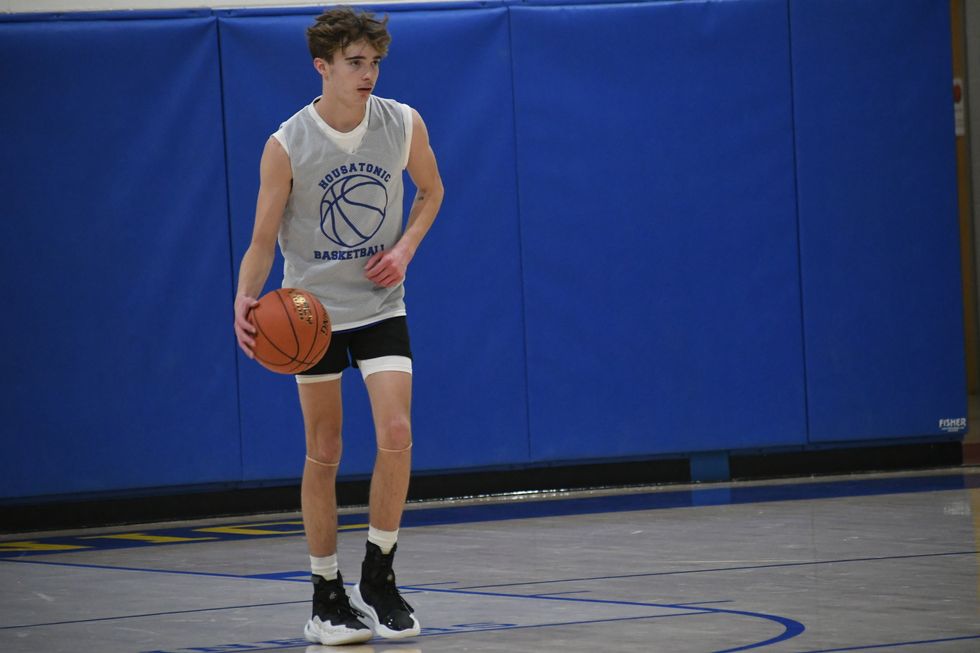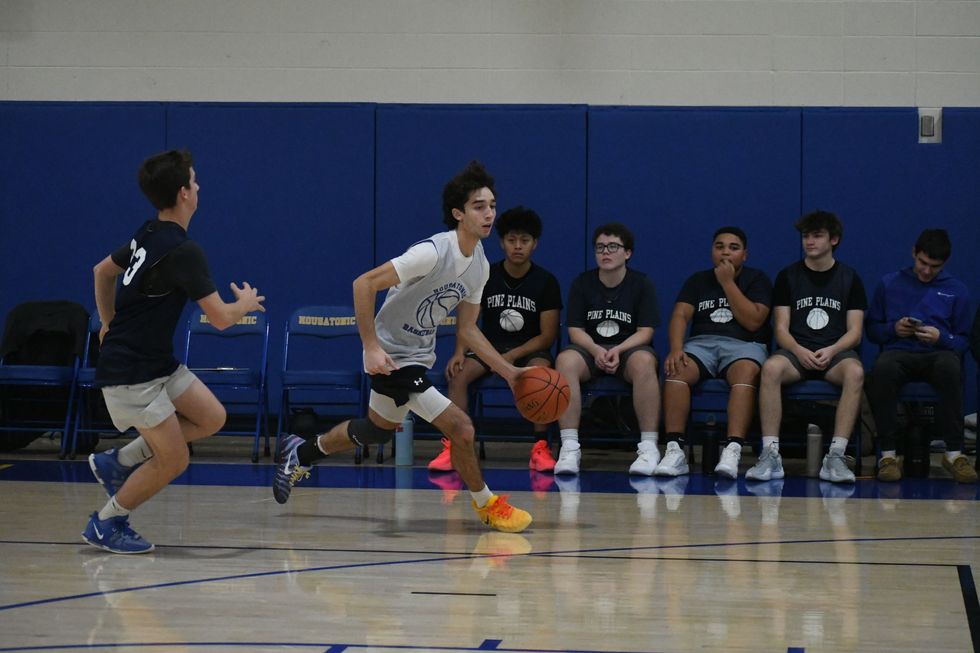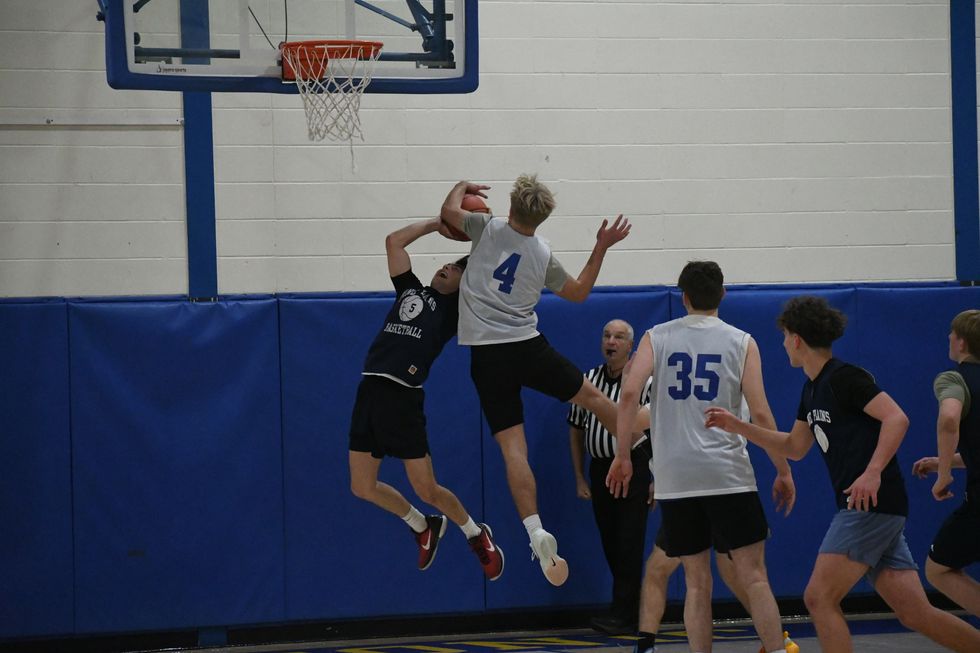Schaghticoke forum draws interest in regional history

Gregg Osofsky, left, of Watershed Center in Millerton, chats with Sachem Hawk Storm at a roundtable at Pine Plains Free Library on Saturday, Dec. 3.
Photo by Deborah Maier

PINE PLAINS — The Schaghticoke First Nations (SFN) Roundtable at Pine Plains Free Library on Saturday, Dec. 3 brought up a wealth of genealogical information, current projects, dreams for going forward, and a host of questions from the audience that reflect the complexities of this moment in our nation’s history. About 60 people were in attendance.
Dyan Wapnick of Little Nine Partners Historical Society began the program with an acknowledgement of the unceded land known as Shekomeko, and a hope that the erasure of its indigenous peoples can be rectified to ensure fairness for their living descendants.
Though the Pine Plains Bicentennial scheduled for March 2023 will celebrate its “discovery,” she noted, it was already inhabited by a complex and sophisticated indigenous culture.
Valerie LaRobardier, SFN Tribal Genealogist, presented a series of slides outlining the difficulties of drawing upon sources from the earliest colonial days. Questions of perspective, of oral versus written sources, alternate name spellings, and similarly named individuals who were numbered for convenience (‘Gideon 33’) made for a good introduction.
Of special interest were the Praying Towns set up in western Massachusetts to Christianize Indians, with British families installed as ‘models of civility’. To a modern eye, it is noteworthy that they were led by “a speculator in Indian lands”, one Ephraim Williams. In the ensuing decade, thousands of acres of Mohican lands were “secured” — many if not most without compensation.
The role of the Moravian Missionaries was a fascinating exception to this phenomenon: they were allies to native Americans; they socialized with them, advised and protected them, when necessary, from the actions of some of the colonists. Their careful documentation, while not always flawless, affords us knowledge that would otherwise be lost.
The post-break presentation by Sachem (Chief) Hawk Storm began with a reminder that the indigenous peoples of the United States were “not as isolated and separate as some would have us believe”. While conceding that there are differences among tribes, he stressed that all in this region were under one governing body, led by those who called themselves simply the Algonquin word for ‘Easterners’.
Sachem Hawk highlighted his group’s many efforts at building the dream of a world where clean food and water, as well as satisfying livelihoods connected to the land, are available to all.
Caskoak (‘place of the herons’), their 73-acre parcel near Copake, has already begun its transformation into an Agro-Food-Forestry paradise, with 3000 new trees planted, all of them fruit- or nut-bearing. Plans are afoot to build “a Conservation and Cultural Center where we can host workshops and conferences, bringing indigenous voices from around the world to share their knowledge and experience.” An Indigenous Exchange Program would bring others into Indigenous Peoples communities for “full immersion training”.
What is planned is future-focused stewardship of both land and communities: “Our goal on this land is ecosystem restoration, reconnecting communities with the land, and providing a real-time example of a food-focused initiative that is based on the use of Indigenous Traditional Ecological Knowledge.”
As the meeting drew to a close, audience members raised the thorny issue of recognition by state and federal authorities; and the question of how to deal with historically objectionable artifacts, mascots and other representations — like the head of Sassucus, a Pequot chief, in a local high school’s logo — elicited some spirited responses. The image in question was the side wall, recently painted over, of the former Pine Plains Platter restaurant, depicting Indians in a way that some found offensive. As a counterpoint, Sachem Hawk cited John Gast’s 1892 painting, “American Progress”, with its suggestion that American Indians fled willingly from the new technology of the age. Conversations, he holds, are more educational than obliteration.
Millerton attorney and historian Ed Downey likely spoke for many in the audience when he praised Valerie LaRobardier’s impressive research and commended Dyan Wapnick for giving us the opportunity to understand our world more fully. “That’s the primary reason we study our history”, he said. “To better understand who we now are as a community, we need to know more about those who preceded us here.”
The Salisbury Winter Sports Association (SWSA) will host its annual Junior Jump Camp, a two-day introduction to ski jumping, on Saturday and Sunday, Dec. 27 and 28, from 9 a.m. to 2 p.m. at Satre Hill in Salisbury.
The camp is open to children ages 7 and up and focuses on teaching the basics of ski jumping, with an emphasis on safety, balance and control, using SWSA’s smallest hill. No prior experience is required.
The cost is $50 per child and includes instruction and lunch on both days. For more information or to register, visit www.skireg.com/swsa-camp or email info@jumpfest.org
Jesse Bunce, first selectman of North Canaan.
LITCHFIELD — The Northwest Hills Council of Governments welcomed six newly elected municipal leaders Thursday, Dec. 11, at its first meeting following the 2025 municipal elections.
The council — a regional planning body representing 21 towns in northwest Connecticut — coordinates transportation, emergency planning, housing, economic development and other shared municipal services.
Barkhamsted First Selectman Meaghan Cook, Goshen First Selectman Seth Breakell, Kent First Selectman Eric Epstein, Norfolk First Selectman Henry Tirrell, North Canaan First Selectman Jesse Bunce and Torrington Mayor Molly Spino were each elected to their post in November.
They filled the seats of their predecessors on the COG, who were each given a toast of appreciation: Nick Lukiwsky (Barkhamsted), Todd Carusillo (Goshen), Marty Lindenmeyer (Kent), Matt Riiska (Norfolk), Brian Ohler (North Canaan) and Elinor Carbone (Torrington).
COG Executive Director Rob Phillips said the outgoing members were given a going away mug that read “You’re living the dream still.” Members voted to appoint Warren First Selectman Greg LaCava to fill a vacancy on the Council’s Executive Committee. COG members voted by paper ballot, and LaCava defeated Burlington First Selectman Doug Thompson for the vacant seat.
Ryan Segalla takes a fadeaway shot over a defender.
FALLS VILLAGE — Housatonic Valley Regional High School’s boys basketball team defeated Pine Plains High School 60-22 in a scrimmage Tuesday, Dec. 9. The non-league preseason game gave both sides an opportunity to run the court ahead of the 2025-26 varsity season.
HVRHS’s senior-heavy roster played with power and poise. The boys pulled ahead early and kept their foot on the gas through to the end.
By halftime the score was 33-8. Junior varsity players subbed in for the second half, but not before the starters got some in-game dunk practice. By the end Housatonic totaled 60 points to Pine Plains’ 22.

Nick Crodelle led the Mountaineers offensively with 13 points. Anthony Labbadia and Wyatt Bayer scored nine points each. Anthony Foley scored eight points. Owen Riemer and Ryan Segalla each scored seven points. Peyton Bushnell hit a three-pointer. Jaxon Visockis and Henry Berry each scored two points.
HVRHS begins Berkshire League competition on the road at Nonnewaug High School Tuesday, Dec. 16, with a 6 p.m. tip off.


Katie Moore delivers toys to the Stuff a Truck campaign held by the Kent Volunteer Fire Department last weekend. Donated toys are collected so that parents, who need some assistance, may provide their children with gifts this Christmas. Accepting the donation are elves Fran Goodsell and Karen Iannucci
KENT — Santa’s elves were toasty warm as they collected toys for the children of Kent.
Keeping with annual tradition, Fran Goodsell and Karen Iannucci manned the Stuff a Truck campaign sponsored by the Kent Volunteer Fire Department on Saturday, Dec. 6, and Sunday, Dec. 7. Sitting in front of a fire pit in the firehouse parking lot between donations from residents, they spoke of the incredible generosity displayed every season. That spirit of giving was clear from the piles of toys heaped on a table.
“This is always so gratifying,” said Goodsell, noting that certain businesses, including High Watch Recovery Center, Wilson’s, and Kent and South Kent schools needed a “shout out” for all they’ve done. She said South Kent School focuses on gifts for older children, which is a group that often is overlooked.
Unwrapped contributions are sought for children 1 to 15 years old who might otherwise find little or nothing from Santa, they said. The bounty will be set up at the Community House on Thursday, allowing parents to come and take what they want. If there are still items left, grandparents are invited to “shop.”
The atmosphere was festive Saturday, as a stuffed dog began barking a Christmas tune whenever someone walked in front of it. A large decked-out bear posted at the parking lot entrance reminded passersby of the event. Visiting children were able to get a close-up look at the fire truck and walk through the firehouse if they wished.
Goodsell and Iannucci were very grateful to those who donated wood for the fire pit. “And so many asked if they could bring us coffee or hot chocolate,” said Iannucci.
Goodsell said many who came talked about having grown children who were recipients of the gifts when their families were struggling. “They are so glad to be able to give back,” she said.